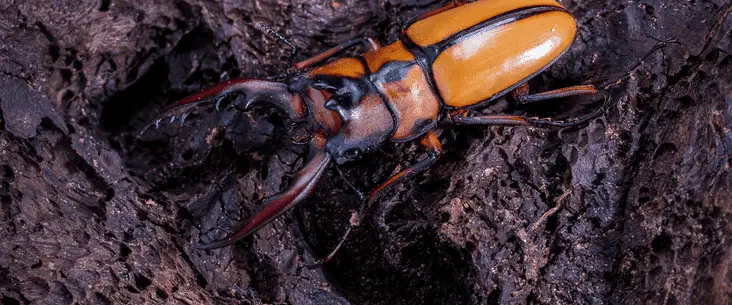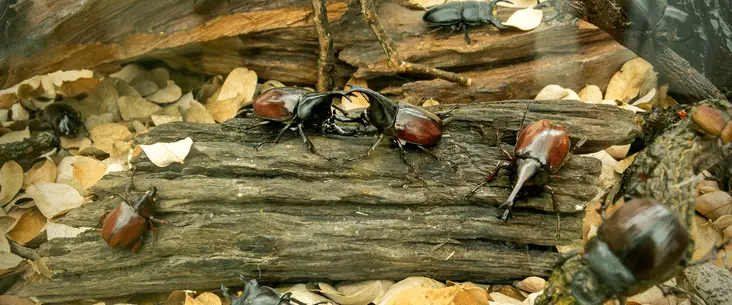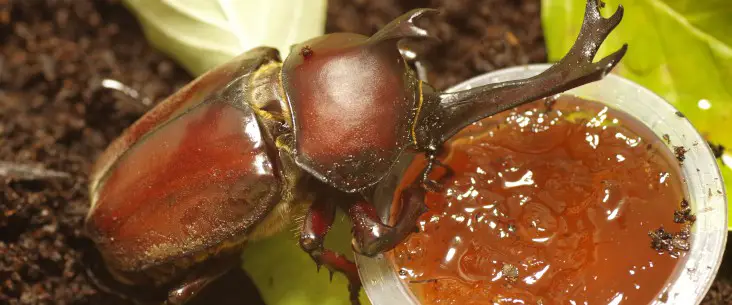Keeping beetles is pretty easy, but there is one thing that you just have to set up right from the start — the substrate. The substrate is a key element when keeping bugs. Therefore it is important to know more about it. Because it is more than just some dirt in the enclosure. In this article, we will discuss all you should know about the substrate for beetles.
The substrate is an important feature in the life of beetles. Especially for beetle larvae, a good quality substrate means a healthy life. Beetle larvae feed on their substrate. But substrate is also important for protection, to rest and to keep hydrated.
It must be clear by now that substrate plays an important role in the life of beetles. But there is much more to it. Let’s dive into it then to learn all about the substrate for beetles in this practical guide.
The role of the substrate for beetles
The substrate has different functions for beetles. We can determine 6 functions that benefit beetles, and that makes clear why they are so dependent on it.
1. Providing food for larvae
The substrate is critical for larvae. It provides most of the food for them to grow and develop into adult beetles. Beetle larvae are detritivores, which means they eat decaying organic matter.
We replicate this by adding decaying leaves and wood into the substrate for the larvae to eat. This is so important, that without a good substrate, you can’t raise any beetle larvae.
2. Providing protection
A substrate provides protection for vulnerable beetle larvae, but it also is the first line protection of adult beetles.
Predators can’t visually detect beetles in the ground, and that makes the substrate a rather safe place to live. It is not only protection from predation, but the substrate also protects from weather, like heavy rain and wind.
3. Providing a place to rest
The substrate is the ideal place to rest. We already mentioned that it is safer for them, protecting them from the elements and predation. This makes it comfortable for them to take a rest.
Although larvae live completely into the substrate and won’t come out until they metamorphosed into an adult beetle, adult beetles often dig in the substrate too to find a safe spot to rest.
4. A place to lay eggs
Although adult beetles mostly live above the soil, they use the substrate to lay their eggs. This makes a lot of sense because where the eggs hatch in the substrate, larvae hatch in the optimal surroundings and can immediately start eating.
Besides that, eggs are quite safe in the substrate and are protected from the elements and most of the predation, although in the wild some predation still occurs.
5. Regulate the humidity
The substrate also benefits the humidity in the enclosure and therefore contributes to hydrate your beetles and beetle larvae. Although adult beetles receive most of the moisture from their food, it is still important to have good humidity.
With larvae, it is even more important to maintain good humidity. Larvae can dehydrate rather quick when not in a moist substrate. They also “drink” from the damp substrate.
One feature of the substrate is to absorb moisture and slowly release it, which make the humidity stable for a longer period.
6. Maintain the temperature
A substrate also works as a layer of isolation and keeps a more stable temperature in the enclosure. The substrate will hold a certain temperature, so when the temperature drops, it stays a bit warmer in the substrate. It is also the other way around. When the temperature rises, the substrate will be a bit cooler.
Beetles will use this more stable temperature when you have a day/night cycle and a temperature fluctuation in your enclosure.
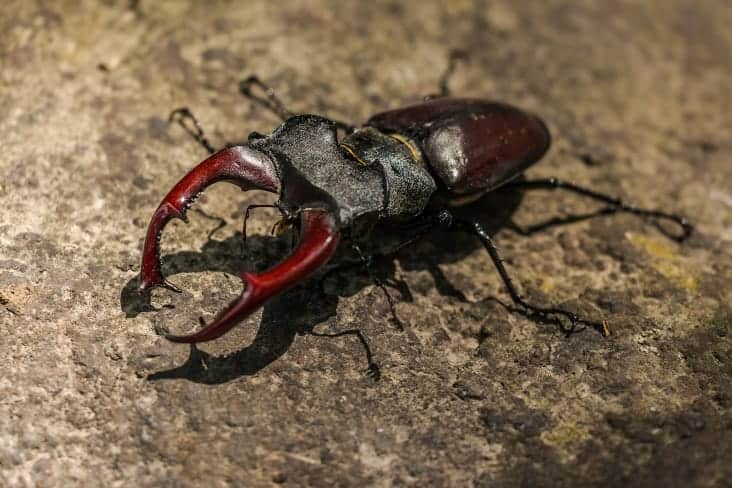
What makes it a good substrate
We repeatedly talk about ‘a good substrate’, but what makes a substrate of a good quality. The substrate consists of different components that combined makes the perfect substrate for beetles. A substrate is mostly important for beetle larvae. Adult beetles also benefit from a substrate, but it is more for them to hide in, lay their eggs or maintain the humidity. Although, it also not a problem to use the same substrate for adults as for larvae.
Of course, you can buy ready-made substrate for beetles in many reptile shops or online pet shops. However, it is good to understand the important components of a good substrate. Making and mixing the substrate yourself is often much cheaper in the long run, and you know exactly what you give to your beetles.
Substrate food component
The most important component is the food component — at least for beetle larvae. It is what keeps beetle larvae alive, healthy and grows into adult beetles.
As a food component, you can use two products. The first is decaying leaf litter. It is the leaves that you can find outside in local parks or forest. Choose leaves from hardwood trees like oak and beech. When collecting these leaves, pick the leaves that are below the freshly fallen ones. These already starts rotting. That is exactly how beetle larvae like them.
The other product is rotten wood. Also, in this case, choose wood from hardwood trees. You’ll need to find for wood that is affected by white-rot fungi. This fungus breaks down the wood in soft pieces, perfect to use as a food component for beetle larvae.
Substrate filler component
A filler component is exactly what it says. It fills the substrate into more volume. You can use different products as a filler. One popular choice is regular (organic) potting soil. Why organic? Often regular potting soil has additives like fertilizer and chemicals. We don’t want that. These chemicals are harmful to beetles.
Don’t trust only on the word ‘organic’. Always read the entire package if chemicals or fertilizers are added. Otherwise, ask the seller if they have products without fertilizer or other chemicals.
You can also use coconut fibre. This is a real clean product. Although favoured for many other bugs, this products does not add any organic matter to the substrate and is more suitable for adult beetles. I prefer potting soil or potting compost over coconut fibre.
Substrate additives
There are also additives you can use to add to your substrate to make it more valuable for beetle larvae.
You can use sawdust as an additive. This is also a product that is used in flake soil (a substrate mix, especially for beetles larvae). Sawdust will slowly decompose and is good as food for beetle larvae. Be aware that sawdust is not edible from day one, but need some time to break down. And make sure that you use sawdust from untreated wood.
You can add some nutrients to the substrate for your beetle larvae. A product you can use is brewer’s yeast or protein baby powder. These high in protein products benefits the growth of beetle larvae. Another product that is sometimes used is calcium powder. Be careful not to use too much calcium powder. Only a light sprinkle is often enough.
Substrate products that should be avoided
We discussed which products are suitable to use as a substrate. However, some products are not suitable to use as a substrate. You could already conclude this one because we specific told to use hardwood trees.
Softwood trees, especially pine trees, are not suitable to use for rotten wood. Even so, the pines are useless for beetle larvae. In fact, many of these trees contain resinous sap which is harmful or even lethal to beetle larvae (and also adult beetles).
Products like vermiculite, perlite, white sand, aquarium sand and gravel are not suitable to use as a substrate, and even in small amounts don’t add any perks to your substrate.
I can’t mention it enough that you always have to be sure that you buy products that don’t contain any fertilizer or other chemical additives. But even when you collect leaves or pieces of wood, don’t do this in the vicinity of farm fields or other places where they might spray pesticides. Even though they haven’t spray recently, pesticides are made to remain on plants for a very long time. The chemicals are often absorbed in the plant tissue and will remain harmful for many years.
Difference between substrate for adults and larvae
Now there is a difference in how to use the substrate for adult beetles and larvae and this is important to understand.
For adult beetles, it serves as a layer where they can dig into rest, and walk on, but the substrate doesn’t need any nutritional value. It helps to maintain the humidity and stabilize the temperature, which benefits the health of beetles. A layer of 5cm (2″) is sufficient for adult beetles of most species. A layer of potting soil is already sufficient for adult beetles.
For larvae, on the other hand, the substrate has a more critical role in their survival. It is their primary food source which helps them develop into beetles. The substrate needs to be nutritional and need to keep the larvae hydrated. When creating a large amount of substrate, the primary focus has to be on the beetle larvae. Larvae need a much thicker layer too. A substrate layer of around 10cm (4″) up to 15cm (6″) is recommended.
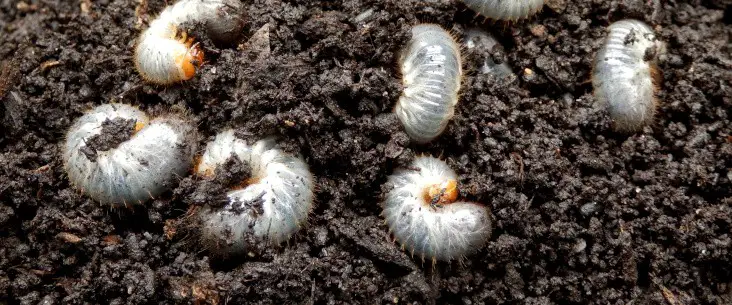
The beetle larvae substrate recipe
It must be clear by now that good quality substrate is essential for beetle larvae. But how to create such a substrate. Here I will give you the substrate recipe that helped me to raise many larvae into beautiful adult bugs. Now, some beetle species prefer more decaying leaves, and others will prefer more decaying wood. In most cases, the recipes down below are well-sufficient for them.
Flower beetle larvae substrate recipe
- 50% decaying leaves (oak, beech)
- 20% decaying wood flakes (oak, beech)
- 30% substrate filler, preferably potting soil
- You could sprinkle some brewer’s yeast
Stag beetle and rhinoceros beetle larvae substrate recipe
- 20% decaying leaves (oak, beech)
- 50% decaying wood flakes (oak, beech)
- 20% substrate filler, preferably potting soil
- 10% sawdust of untreated wood
- You could sprinkle some brewer’s yeast
For both mixtures, add all products into a large plastic container and mix it together. Try to slice down the decaying leaves and decaying wood into small pieces. When mixed, it is ready to use.
When refreshing the substrate, keep 1/4 to 1/3 of the old substrate in the enclosure and let it on the bottom. Place the new substrate on top of it without mixing both together. By doing this will help the larvae’s digestive tract (with all bacteria) get used to the new substrate.
Then, make it damp by mist spraying some water on it. Only make it damp, not soaking wet. And you are ready to go!
Quick tips for your beetle substrate
- When you see a lot of excrement pellets, it is time to refresh the substrate. Never refresh all of it. Always leave a small part of the old substrate in the enclosure and place the new one on top of it.
- Keep your substrate moist at all times. Mist spray water on it to keep it damp (but not soaking wet). When you grab the substrate, make a ball of it, you can test if your substrate is moist enough. If the ball falls apart, the substrate is too dry. If you squeeze in the substrate ball and moisture drips out, the substrate is too wet.
- You can use substrate for larvae also for your adults. However, adult beetles don’t need such a thick layer of the substrate.
- Make sure you never use products that contain fertilizer or other chemicals (like pesticides). Also, when collecting products from nature, avoid places where they possibly use heavy fertilizer or pesticides.
What does the substrate cost?
How much does the substrate cost? Fortunately, you can keep it rather cheap, or even completely free if you use only products from nature (and that also works perfectly fine).
If you use some products like coconut fibre or potting soil, together with some brewer’s yeast, it will cost you around $0.50 to $1.00 a litre. So, the substrate for beetles is still rather cheap.
You can also buy ready-made beetle larvae substrate. Often this is called flake soil and will cost around $1.50 to $2.50 a litre. Also, leaf litter or decaying wood flakes are often around $1.00 a litre for each product.
So, buying ready-made products is a bit more expensive, around twice to three times the price. But you don’t have the trouble to collect all the items and prepare the substrate before you can use it.
Share this page!

